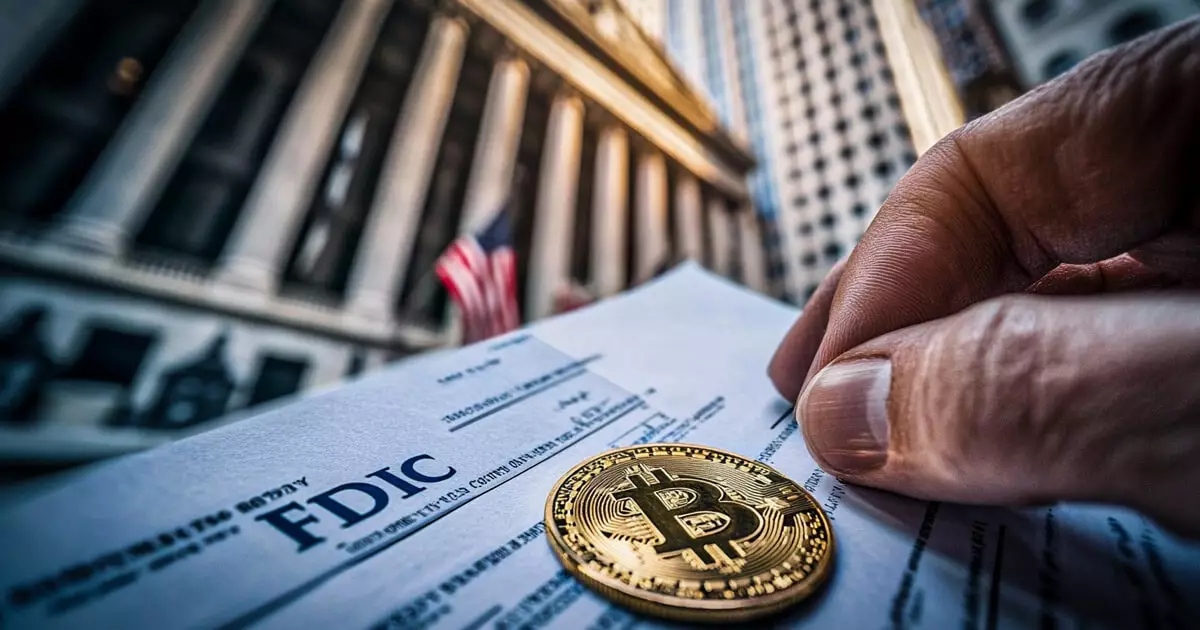The Federal Deposit Insurance Corporation (FDIC) has recently announced a monumental shift in its regulatory stance towards cryptocurrency-related activities. As articulated in Financial Institution Letter (FIL-7-2025), acting banks under FDIC oversight can engage in crypto pursuits without the precondition of agency approval, provided they adhere to established safety and soundness standards. This change marks a pivotal moment in the government’s approach to financial innovation and could potentially reshape the landscape for cryptocurrency in the United States.
This policy shift boldly rescinds the earlier FIL-16-2022, which, to many, represented a heavy-handed approach stifling growth in a rapidly evolving market. Travis Hill, the FDIC’s acting chairman, characterized this development as “turning the page” on a “flawed approach” that relied heavily on suppression and ambiguity. The retraction of previous policies that served as informal “pause” mechanisms amid fears of financial instability is a clear indication that regulatory bodies are beginning to recognize the importance of innovation rather than stifling it through bureaucratic inertia.
From Constraint to Opportunity
For years, the crypto industry in the U.S. faced stifling inertia, evidenced by reports of banks receiving so-called “pause” letters that constrained their operational capacities within the digital asset sphere. Critics have labeled these regulatory tactics as part of a larger scheme—dubbed “Operation Chokepoint 2.0″—that aimed to impede the growth of an industry that holds immense potential. Hill’s acknowledgment of these non-transparent tactics reflects a broader dilemma: the legacy systems that form the backbone of American banking are ill-equipped to accommodate the dynamism associated with blockchain technology.
The evolving framework aims to liberate banks from the shackles of over-regulation. By allowing them to explore crypto offerings more freely, the FDIC opens the door for innovation that could transform financial services in ways we have yet to imagine. The decision essentially democratizes access to emerging financial technologies, encouraging banks to be not just reactive, but proactive in their engagement with the crypto sector.
Collaboration Over Isolation
The FDIC’s newfound willingness to cooperate with entities like the President’s Working Group on Financial Markets marks a significant move towards a more unified regulatory landscape. This inter-agency collaboration is crucial for laying down a stable roadmap for cryptocurrencies that harmonizes with existing laws. By moving away from ad-hoc interventions towards a structured approach, regulators can assure industry participants and consumers alike that they are working towards a comprehensive framework that embraces the benefits of digital assets.
Bo Hines, the Executive Director of the Presidential Working Group on Digital Assets Markets, has referred to this as a “huge step forward,” encapsulating the optimism shared by many within the financial sector. It signifies a recognition that crypto is not just a passing fad but a legitimate facet of modern financial systems requiring thoughtful integration rather than punitive measures.
Rethinking Compliance Standards
An essential component of this policy change is the call to reevaluate the application of the Bank Secrecy Act (BSA). Hill has argued that compliance with such laws should not act as a deterrent to innovative banking services. Too often, strict interpretation of existing regulations has stifled access to banking for entities involved in crypto activities. The FDIC’s new direction suggests a willingness to rethink how these regulations are interpreted and enforced, paving the way for tokenized deposits and other blockchain-based solutions.
This shift is crucial not only for fostering innovation within banks but also for enhancing consumer access to diverse financial products. Creating an environment where innovative financial services can flourish will ultimately lead to better choices for consumers, decreasing the risk of exclusion from the burgeoning digital economy.
A Pivotal Moment for the Crypto Industry
As the dust settles from this policy shift, the implications for the cryptocurrency sector are profound. The FDIC is aligning itself with other regulatory bodies, such as the U.S. Securities and Exchange Commission (SEC), which is crafting its own frameworks around digital assets. By doing so, the FDIC contributes to a more cohesive regulatory environment that recognizes the legitimacy of cryptocurrency, allowing for what could be a renaissance in financial services.
The environment for crypto in the U.S. appears to be turning a corner, as regulatory bodies begin to embrace the complexity and potential of digital assets rather than fear them. This signals an exciting new chapter not only for banks but for the entire financial system as it adapts to the demands of a tech-savvy consumer base eager for modern solutions. Instead of staring down the specter of regulation, the crypto industry can finally breathe a sigh of relief as it embarks on this uncharted territory with renewed vigor and optimism.

